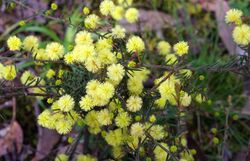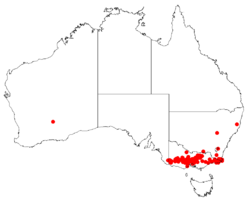Biology:Acacia aculeatissima
| Thin-leaf wattle | |
|---|---|

| |
| Scientific classification | |
| Kingdom: | Plantae |
| Clade: | Tracheophytes |
| Clade: | Angiosperms |
| Clade: | Eudicots |
| Clade: | Rosids |
| Order: | Fabales |
| Family: | Fabaceae |
| Subfamily: | Caesalpinioideae |
| Clade: | Mimosoid clade |
| Genus: | Acacia |
| Species: | A. aculeatissima
|
| Binomial name | |
| Acacia aculeatissima J.F.Macbr.
| |

| |
| Occurrence data from AVH | |
Acacia aculeatissima, commonly known as thin-leaf wattle or snake wattle,[1] is a shrub belonging to the genus Acacia and the subgenus Phyllodineae that is native to parts of eastern Australia .
Description
The shrub has an erect to decumbent habit and typically grows to a height of 0.3 to 1 m (1 ft 0 in to 3 ft 3 in)[2] and has ribbed stems that are covered in stiff short hairs. The phyllodes are fine and prickly with a length of 5 to 12 mm (0.20 to 0.47 in) and a width of 0.5 to 1 mm (0.020 to 0.039 in) and have four veins that are usually bent downwards.[3] It blooms between August and November and produces inflorescences with pale yellow flowers.[2] Each inflorescence occurs a one to three spherical flowers on individual stalks found in the leaf axils. After flowering narrow seed pods form that are straight or shallowly curved to with a length of around 6 cm (2.4 in).[3]
Taxonomy
The species was first formally described by the botanist James Francis Macbride in 1919 in the article Notes on certain Leguminosae s published in the Contributions of the Gray Herbarium of Harvard University. The only synonyms are Acacia tenuifolia and Racosperma aculeatissimum.[4]
Distribution
It is found in south western New South Wales where it is considered rare and Victoria where it is more common. It is often a part of Eucalypt forest communities and grows in sandy loamy clay soils over sedimentary substrate.[2]
See also
References
- ↑ "Acacia aculeatissima J.F.Macbr.". Wattle - Acacias of Australia. Department of the Environment and Energy. https://apps.lucidcentral.org/wattle/text/entities/acacia_aculeatissima.htm.
- ↑ 2.0 2.1 2.2 "Acacia aculeatissima J.F.Macbr.". PlantNet. Royal Botanic Garden, Sydney. http://plantnet.rbgsyd.nsw.gov.au/cgi-bin/NSWfl.pl?page=nswfl&lvl=sp&name=Acacia~aculeatissima.
- ↑ 3.0 3.1 "Acacia aculeatissima". Yarra Ranges Shire Council. 2009. http://fe.yarraranges.vic.gov.au/Residents/Trees_Vegetation/Yarra_Ranges_Plant_Directory/Yarra_Ranges_Local_Plant_Directory/Lower_Storey/Herbs_and_Groundcovers_1m/Acacia_aculeatissima.
- ↑ "Acacia aculeatissima J.F.Macbr.". Atlas of Living Australia. Global Biodiversity Information Facility. https://bie.ala.org.au/species/http://id.biodiversity.org.au/node/apni/2919577.
Wikidata ☰ Q9561836 entry
 |

